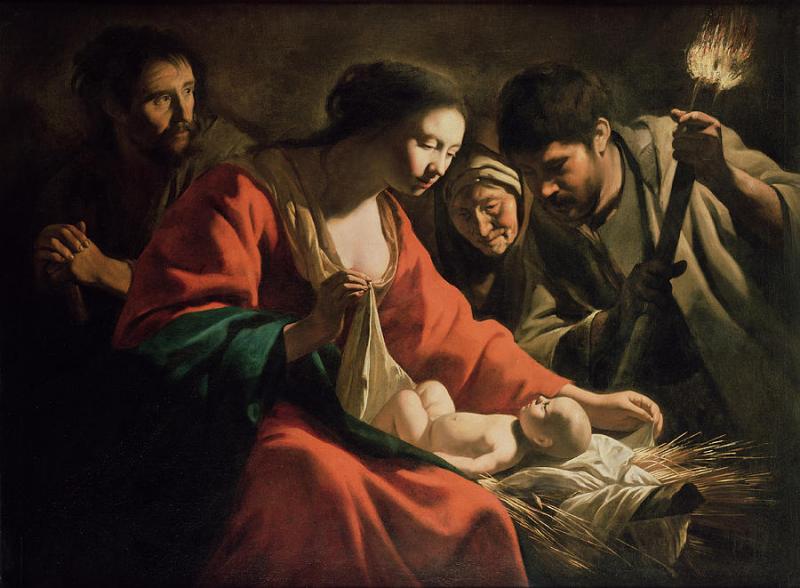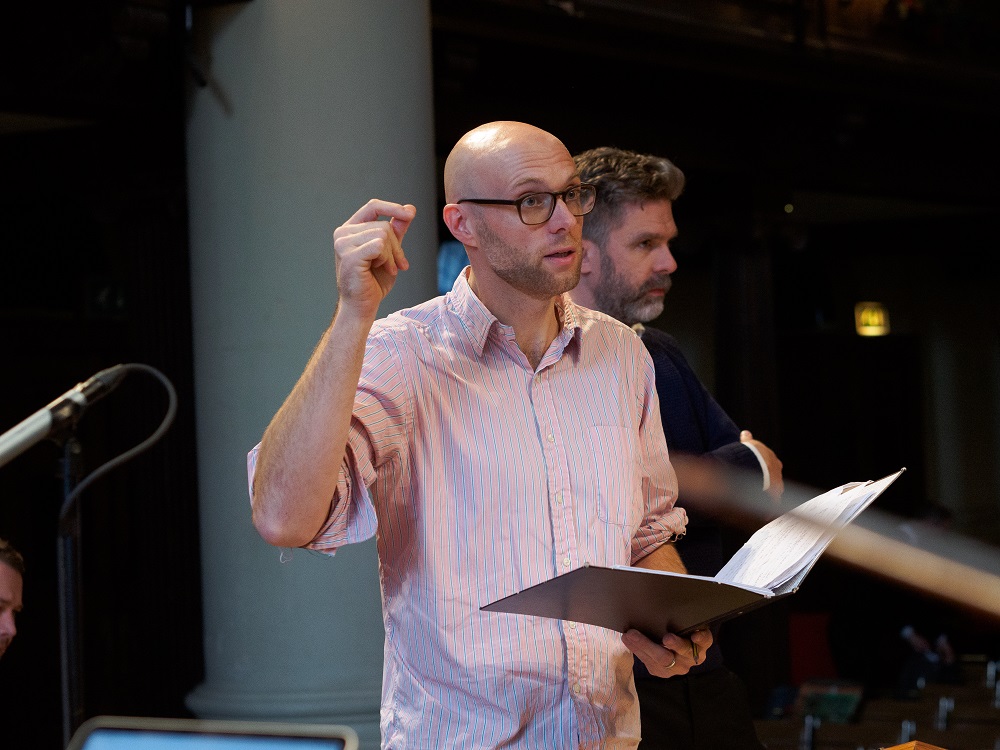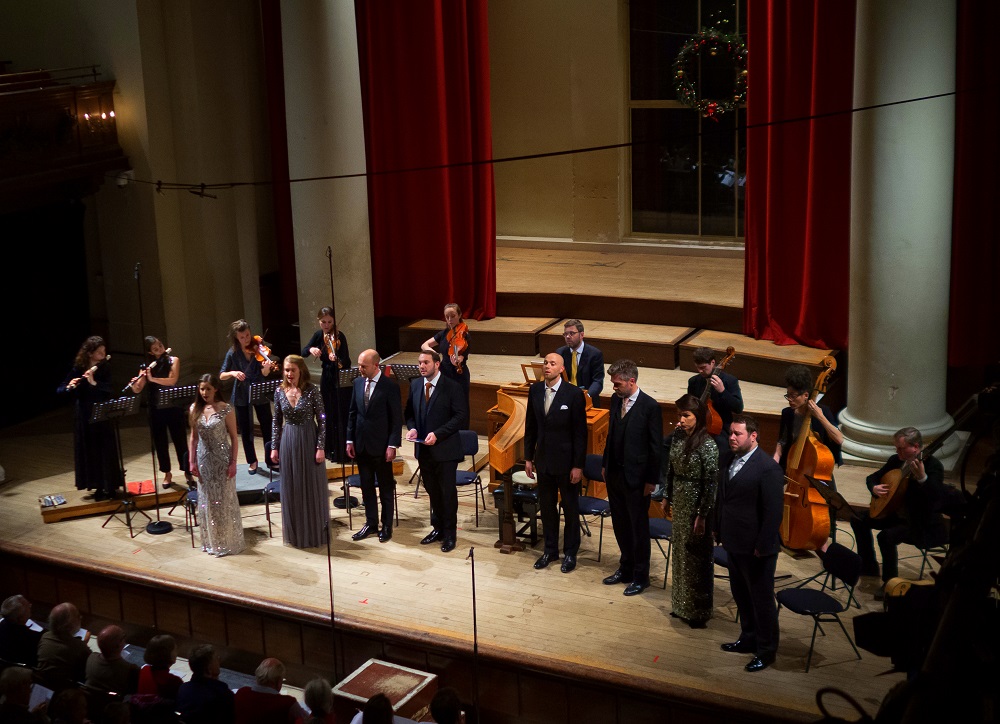Charpentier Christmas settings, Solomon's Knot, St John's Smith Square review - pastoral shades | reviews, news & interviews
Charpentier Christmas settings, Solomon's Knot, St John's Smith Square review - pastoral shades
Charpentier Christmas settings, Solomon's Knot, St John's Smith Square review - pastoral shades
Vibrancy in excelsis for two varied and tender 17th century curiosities

There is no mention of Marc-Antoine Charpentier in David Cairns's comprehensive Berlioz biography.
Would an all-Charpentier evening be too much of a good thing? At the end of the slightly later In navitatem Domini canticum, the first-half work, sympathetic presenter, bass and founding artistic director Jonathan Sells (pictured below in rehearsal with Alex Ashworth, first of two images by Alexander Barnes/Apple and Biscuit) announced that if we'd had enough of Charpentier, we could buy the group's new CD of Bach's Magnificat. Strange to think that in the year of the Pastorale, a boy was born in Eisenach who would become the most wonderful of all.  No, Charpentier doesn't entirely transcend the manners of his Lully-centric Parisian time; the wonders are more in the sequences and contrasts of two works that begin with mankind in dire need of salvation, proceed gently with two instrumental night pictures conventional in essence but moving in presentation - especially the string-quintet magic of In nativitatem - and then set shepherds dancing with good news (Sells' tambourine joining the other players).
No, Charpentier doesn't entirely transcend the manners of his Lully-centric Parisian time; the wonders are more in the sequences and contrasts of two works that begin with mankind in dire need of salvation, proceed gently with two instrumental night pictures conventional in essence but moving in presentation - especially the string-quintet magic of In nativitatem - and then set shepherds dancing with good news (Sells' tambourine joining the other players).
In fact there was sufficient contrast between the two works: In nativitatem slightly more austere as well as shorter, in church Latin for St Paul-St Louis in the Marais, with its unique halting reminder of Christ born into poverty ("you are so needy, you cry so, you are so cold, you love so"), the Pastorale composed to a more naive French text for the household of Mademoiselle de Guise (with the added pathos that the last male heir of the house of Guise had died at the age of five a decade earlier). Its highlights - detachable if anyone's looking for special Christmas numbers - are the "Gloire"s of four angels (the women's spangly tops and dresses paying off here as visual complement to singing vibrant in excelsis) and the simple but touching polyphony of the final shepherd's chorus, with a beautiful phrase resounding as it's passed around each voice-part). What a talented household of singers, chambermaids included, the Hotel de Guise's must have been.  Solos were taken with character, even if in their dramatic presentation most of Solomon's Knot could do with a lesson or two in learning to stand naturally and seem relaxed (Marcus Farnsworth, with plenty of stage experience, is used to it). The group is lucky, or has simply chosen well, to have a clarion high tenor in Peter Davoren, crucial in the first of the evening's works, and a true bass in Alex Ashworth. Claire Lloyd-Griffiths brought light and intensity as the Pastorale's announcing Angel - originally sung by a clearly talented 20 year old soprano - and Zoë Brookshaw landed the plum cameo of a shepherdess lamenting the death of her favourite ewe, devoured by a wolf while most of the others have rushed off to see the Christ Child. Fatuously, one might suggest a final touch à la Peter and the Wolf - the sheep, swallowed whole, bleating from within the belly of the beast - but by the end, Charpentier has turned universal before a final joyous dance march.
Solos were taken with character, even if in their dramatic presentation most of Solomon's Knot could do with a lesson or two in learning to stand naturally and seem relaxed (Marcus Farnsworth, with plenty of stage experience, is used to it). The group is lucky, or has simply chosen well, to have a clarion high tenor in Peter Davoren, crucial in the first of the evening's works, and a true bass in Alex Ashworth. Claire Lloyd-Griffiths brought light and intensity as the Pastorale's announcing Angel - originally sung by a clearly talented 20 year old soprano - and Zoë Brookshaw landed the plum cameo of a shepherdess lamenting the death of her favourite ewe, devoured by a wolf while most of the others have rushed off to see the Christ Child. Fatuously, one might suggest a final touch à la Peter and the Wolf - the sheep, swallowed whole, bleating from within the belly of the beast - but by the end, Charpentier has turned universal before a final joyous dance march.
The sunrise aspect is fascinating, too, especially as text (the sun illumines only half the world; Christ is all-encompassing): a special salute there to artistic advisor James Halliday for fusing versions to give a London premiere of sorts. The encore, Charpentier's O oriens, encapsulated the twin poles of gravity and tripping joy. Who couldn't feel the better for hearing this?
rating
Explore topics
Share this article
The future of Arts Journalism
You can stop theartsdesk.com closing!
We urgently need financing to survive. Our fundraising drive has thus far raised £49,000 but we need to reach £100,000 or we will be forced to close. Please contribute here: https://gofund.me/c3f6033d
And if you can forward this information to anyone who might assist, we’d be grateful.

Subscribe to theartsdesk.com
Thank you for continuing to read our work on theartsdesk.com. For unlimited access to every article in its entirety, including our archive of more than 15,000 pieces, we're asking for £5 per month or £40 per year. We feel it's a very good deal, and hope you do too.
To take a subscription now simply click here.
And if you're looking for that extra gift for a friend or family member, why not treat them to a theartsdesk.com gift subscription?
more Classical music
 Kilsby, Parkes, Sinfonia of London, Wilson, Barbican review - string things zing and sing in expert hands
British masterpieces for strings plus other-worldly tenor and horn - and a muscular rarity
Kilsby, Parkes, Sinfonia of London, Wilson, Barbican review - string things zing and sing in expert hands
British masterpieces for strings plus other-worldly tenor and horn - and a muscular rarity
 From Historical to Hip-Hop, Classically Black Music Festival, Kings Place review - a cluster of impressive stars for the future
From quasi-Mozartian elegance to the gritty humour of a kitchen inspection
From Historical to Hip-Hop, Classically Black Music Festival, Kings Place review - a cluster of impressive stars for the future
From quasi-Mozartian elegance to the gritty humour of a kitchen inspection
 Shibe, LSO, Adès, Barbican review - gaudy and glorious new music alongside serene Sibelius
Adès’s passion makes persuasive case for the music he loves, both new and old
Shibe, LSO, Adès, Barbican review - gaudy and glorious new music alongside serene Sibelius
Adès’s passion makes persuasive case for the music he loves, both new and old
 Anja Mittermüller, Richard Fu, Wigmore Hall review - a glorious hall debut
The Austrian mezzo shines - at the age of 22
Anja Mittermüller, Richard Fu, Wigmore Hall review - a glorious hall debut
The Austrian mezzo shines - at the age of 22
 First Person: clarinettist Oliver Pashley on the new horizons of The Hermes Experiment's latest album
Compositions by members of this unusual quartet feature for the first time
First Person: clarinettist Oliver Pashley on the new horizons of The Hermes Experiment's latest album
Compositions by members of this unusual quartet feature for the first time
 Gesualdo Passione, Les Arts Florissants, Amala Dior Company, Barbican review - inspired collaboration excavates the music's humanity
At times it was like watching an anarchic religious procession
Gesualdo Passione, Les Arts Florissants, Amala Dior Company, Barbican review - inspired collaboration excavates the music's humanity
At times it was like watching an anarchic religious procession
 Classical CDs: Camels, concrete and cabaret
An influential American composer's 90th birthday box, plus British piano concertos and a father-and-son duo
Classical CDs: Camels, concrete and cabaret
An influential American composer's 90th birthday box, plus British piano concertos and a father-and-son duo
 Cockerham, Manchester Camerata, Sheen, Martin Harris Centre, Manchester review - re-enacting the dawn of modernism
Two UK premieres added to three miniatures from a seminal event of January 1914
Cockerham, Manchester Camerata, Sheen, Martin Harris Centre, Manchester review - re-enacting the dawn of modernism
Two UK premieres added to three miniatures from a seminal event of January 1914
 Kempf, Brno Philharmonic, Davies, Bridgewater Hall, Manchester review - European tradition meets American jazz
Bouncing Czechs enjoy their Gershwin and Brubeck alongside Janáček and Dvořák
Kempf, Brno Philharmonic, Davies, Bridgewater Hall, Manchester review - European tradition meets American jazz
Bouncing Czechs enjoy their Gershwin and Brubeck alongside Janáček and Dvořák
 Solomon, OAE, Butt, QEH review - daft Biblical whitewashing with great choruses
Even a top soprano and mezzo can’t make this Handel paean wholly convincing
Solomon, OAE, Butt, QEH review - daft Biblical whitewashing with great choruses
Even a top soprano and mezzo can’t make this Handel paean wholly convincing
 Two-Piano Gala, Kings Place review - shining constellations
London Piano Festival curators and illustrious friends entertain and enlighten
Two-Piano Gala, Kings Place review - shining constellations
London Piano Festival curators and illustrious friends entertain and enlighten
 Echo Vocal Ensemble, Latto, Union Chapel review - eclectic choral programme garlanded with dance
Beautiful singing at the heart of an imaginative and stylistically varied concert
Echo Vocal Ensemble, Latto, Union Chapel review - eclectic choral programme garlanded with dance
Beautiful singing at the heart of an imaginative and stylistically varied concert

Add comment